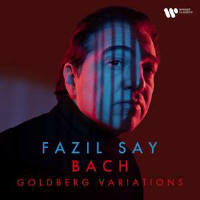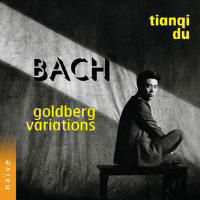|
Warner 5419723396 |
Naïve V7566 7566 |
 |
 |
|
Code barres / Barcode : 5054197233968 |
Code barres / Barcode : 3700187675660 |
|
|
|
Texte paru dans: / Appeared in: |
|
|
Outil de traduction |
|
|
Warner/Erato continues to feed the market with Bach Goldberg Variations piano releases, from recent versions by DongHyek Lim (11/08), Alexandre Tharaud (11/15), Beatrice Rana (4/17), David Fray (12/21) and the late Nicholas Angelich (8/11) to their latest contender, Faz?l Say. Given this composer-pianist’s past propensity for interpretative monkey shines, Say’s Goldbergs are more straightforward than you’d expect, while unsurprisingly nimble-fingered. Subtle variations in touch, colour, accent and dynamics abound. The pianist observes all the repeats and basically treats each variation as its own world, in contrast to the cumulative trajectory favoured by Gould, Hewitt or Schiff. His creativity starts coming into focus after Var 7, beginning with Var 8’s striking ornaments. Perky accents and playful shifts in voicing vivify Var 10’s contrapuntal lines. Var 12 (the canon at the fourth) receives an uncommonly gentle and legatoorientated reading, as does Say’s brisk and liberally pedalled Var 15. He brings similar animation and pianistic orientation to the intense minor-key ‘Black Pearl’ Var 25. It may sound Chopinesque to some, yet Say’s sensitivity and harmonic awareness win me over. Interestingly, Vars 19 and 20 share a common basic pulse. While many young pianists speed through the latter like an Olympic event, Say’s moderation allows the cross-hand lines to emerge both clearly and buoyantly. In fact, all the variations originally scored for two harpsichord manuals benefit from Say’s reasonable and steadily held tempos. Whether or not one agrees with each and every detail, there’s no doubt that Faz?l Say makes this work his own. The young Chinese pianist Tianqi Du does not personalise or execute the Goldbergs to Say’s refined degree, although his embellishments go further. He, too, observes all repeats, differentiating them in myriad ways. For example, he follows his initial and rather uneventful expositions of the Var 8 and 13 A sections with more assertive reboots, so to speak. In Var 10’s Fughetta, Du alters dynamics at each section’s start, yet the overall effect is a mite square rather than joyous. He follows his rather bland Var 11 and 12 with an eloquently sung-out Var 13. For all of Du’s imaginative phrasings and ornaments in the French Overture Var 16’s opening section, the lack of a basic, unifying pulse undermines his intentions, in contrast to Alexandre Tharaud’s comparable yet more incisive conception. Nor do extra curlicues infuse Var 18 (the canon at the sixth) with the spark it needs. Var 19’s crisply delineated cross-hand patterns get slightly slower and heavier once the triplets kick in. Similarly, Var 26’s vertigo-inducing keyboard-writing loses steam as it progresses and pales next to Glenn Gould’s ebullience and ironclad rhythm. I fail to hear the ‘chaste, desolate and disembodied’ qualities that one respected colleague gleaned from Du’s enervated, slow-motion Var 25. Here, for example, Evgeni Koroliov (Hänssler, 3/00) proves even slower, yet his phrasing illuminates the music’s harmonic tension to an infinitely higher degree. The sevenminutes-plus-double-repeat Aria da capo, though, held my attention via Du’s deft pedal effects and dynamic manipulation. Clearly Du has ideas and strong interpretative ambitions but he does not yet realise them with consistently pinpointed character and commitment. Once he does, he’ll give us the Goldberg Variations of his dreams.
|
|
_small.jpg)


